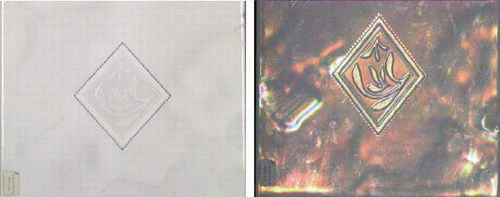March 20, 2007 feature
Multi-angle scanner sees objects from multiple perspectives

Pablo Picasso might have taken an interest in one of the latest advances of imaging technology, nearly a hundred years after his invention of cubism. The artist famous for his style of portraying objects from multiple angles in a single drawing would find at least a few similarities in engineer Andrew Forrest’s multi-angle scanner.
As Forrest explains in a recent study in the Journal of Optics A: Pure and Applied Optics, nearly every current imaging system uses light reflected from a single narrow range of angles to produce an image—from digital cameras to our own eyes. However, much more information could be found in an object by knowing the angular information. By shining light on an object from different angles, and then combining the light from these multiple angles, we could gain a much more detailed understanding of surface texture, and even see things that we couldn’t see before.
“As far as I know, this is the only scanner that images multiple angles simultaneously,” Forrest told PhysOrg.com. “It is going through the patent process as we speak. Other scanners have been used for very high spatial resolution, imaging at angles, etc., but in general these have been special purpose, that is, not an attempt to get all possible information at once. The main advantage of this scanner is imaging multiple angles simultaneously. This allows accurate comparisons of light from the same point at different angles allowing detection of scratches, changes in texture, etc.”
Forrest, an engineer at the Imperial College of Science, Technology and Medicine in London, has designed a high-speed, high-resolution scanner that can provide views of objects from as many as six different angles over a range of four degrees. Using primarily small inexpensive components, the instrument marks a step toward the “final goal,” as Forrest explains, of separating all angles, wavelengths and polarizations of light from an object.
“I have spent considerable time developing several special purpose optical instrumentations for tile quality control—for example, a moiré interferometer that was granted a patent in 1991,” Forrest explained. “Because these are so specialized, they tend to be expensive and limited in use to a very small application area. I thought that it might be better to produce an imaging system that gave as much information as possible that could be used in a wide variety of applications, covering the uses of several special purpose instruments. This is the origin of attempting to get every angle, wavelength and polarization at once.”
The basis of the scanner design involves a parabolic mirror, two flat mirrors and detector. A 15-mW helium-neon laser shines an array of parallel light beams onto a rotating prism, which angles the beams toward the parabolic mirror. After bouncing off the two flat mirrors and the object, the light travels back to the parabolic mirror and finally enters the detector, which separates the different angles of light before they are superimposed to form an image. A high-speed prototype could perform 4000 scans per second.
“The biggest challenge was getting a working system with low-cost optics,” said Forrest. “Because of the nature of a scanner, at least one optical component must be as big as the object being viewed. If this were not the case, different parts of the object would have to be illuminated and viewed at different angles, negating the point of the scanner. This design just uses one large curved optical component. This is the absolute minimum possible.”
The first multi-angle scanning system has a resolution of about 100 pixels per mm2, which, Forrest says, is not very high by scanner standards. With its six independent output channels, a typical 400-mm surface would have nearly 100 million data points. Forrest tested the scanner’s effectiveness on ceramic tiles, with results demonstrating more prominent surface texture of the tiles, including fingerprints and scratches due to the multiple light angles.
“Possible applications include quality control, which is where the work started,” Forrest said. “I have had interests ranging from jet engine parts to leather production. Forensic imaging, where scuff marks or scratches on a surface can be very important, is another one of the areas I would like to pursue.”
While this first demonstration has shown several exciting results, Forrest is also looking into future improvements. The scanner breaches the limits of data acquisition and storage, for one, and limitations in the laser source also cause speckles that create noise on the image. However, the scanner offers promising abilities in simultaneous imaging with multiple angles, providing new perspectives of the objects around us.
“Since the published work, we have developed a system that uses more optics to obtain an angular range of up to 40 degrees and 16-plus channels,” Forrest added. “Speed of operation is relatively easy to obtain; it just costs money. The system needs a high-power laser, very fast sensitive detectors and a very fast rotating prism scanner.”
Citation: Forrest, A. K. “A scanner with multi-angle response.” J. Opt. A: Pure Appl. Opt. 9 (2007) 335-340.
Copyright 2007 PhysOrg.com.
All rights reserved. This material may not be published, broadcast, rewritten or redistributed in whole or part without the express written permission of PhysOrg.com.





















